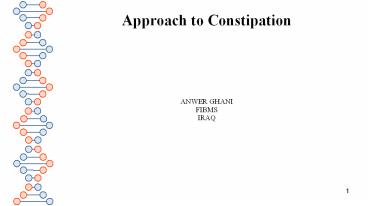Approach to Constipation - PowerPoint PPT Presentation
Title:
Approach to Constipation
Description:
Approach to Constipation – PowerPoint PPT presentation
Number of Views:39
Title: Approach to Constipation
1
Approach to Constipation
- ANWER GHANI
- FIBMS
- IRAQ
2
.
- Chronic constipation is a worldwide problem.
- It can be either primary or secondary.
- It is often, erroneously, considered as a single
disease but it is a complex and multifaceted
syndrome.
3
The criteria for constipation includes two or
more of the following symptoms
4
Definitions
- Constipation
- Derived from latin constipare (to crowd together)
- Difficult stool passage ( Sensation of incomplete
evacuation, Straining at stool) - Decreased stool frequency ( Normal frequency
difficult to define, 95 of people pass gt3 stools
per week) - Therefore, 3 or less stools per week is defined
as Constipation
5
.
6
.
- .
7
.
- .
8
.
- ,
9
.
- The term primary constipation itself hides
different conditions, such as irritable bowel
syndrome with constipation (IBS-C), functional
constipation, functional defecation disorders,
and rectal hyposensitivity.
10
Hx
- History can identify alarm symptoms, such as
weight loss, bloody stools, anemia, or a family
history of colon cancer. - History can identify conditions potentially
associated with constipation, such as dietary
mistakes, low physical activity the use of
constipating drugs, metabolic, psychiatric, or
neurological diseases and previous
perineal-pelvicabdominal or obstetric-gynecologic
al surgery.
11
Red flags
- ,
12
- In case of alarm symptoms/signs, colonoscopy is
recommended.
13
Ex
- The examination can detect a possible
gastrointestinal mass. - Examination should include inspection of the
anorectal region and exploration of the rectum. - A digital rectal examination should detect any
signs of organic disease or obstructed defecation
(rectal masses, fecal impaction, stricture,
rectal intussusception, or rectocele).
14
- ve alarm s? colonscoppy. (abno Ve ? Rx, Abno
-ve ? Chronic C) - -ve alarm s?drugs Hx (ve drug Hx ? stop drugs,
- -ve drug Hx ? chronic c)
15
Rx
- ,
16
.
- many patients will benefit from abolishing or
reducing medications that cause constipation.
17
.
- many patients will benefit from recommending
changes in lifestyle and diet with correct fluid
(at least 1.5 l/day) and fiber (25 mg/day)
intake.
18
.
- Increased intake of whole fruits and vegetables
significantly reduced fecal transit time by 14 h
and increased the number of daily bowel movements
by 0.4 and daily wet fecal weight by 118 g
compared to 100 fruit and vegetable juices.
19
.
- If diet management is not sufficient, it is
mandatory to move to a second step encompassing
the use of fiber supplementations and osmotic
laxatives.
20
.
- ,
21
.
- If osmotic laxatives are ineffective, it is
possible to use - -stimulant or softening laxatives then
- -prokinetics or prosecretory agents.
- In this subset of patients, further tests such
as anorectal manometry and/or entero-defecography
and/or colonic transit time are advisable.
22
- .
23
Laxative use
- .
24
Other therapeutic options
- - pelvic floor rehabilitation
- -sacral nerve stimulation
- -anorectal surgery
25
Other tests
- colpo-cystoentero-defecography
- magnetic resonance (MR) defecography
- dynamic transperineal ultrasonography (DTP-US)
26
.
- Colonic and/or gastrojejunal manometry should be
performed in patients with serious slow-transit
constipation
27
Approach to Rx of Chronic C
- Diet (fluid and fibers)
- No resp ? suppl fibers
- No resp ? bulck laxative , Osmotic laxa
- No resp ? stimulant or softening laxat
- No resp ? Prokinetics (prucalopride),
Prosecretory (linaclotide, lubiprostone) - No resp ?Pelvic floor rehabilitation.
- No resp ? Sacral nerve stimulation, Anorectal
surgery, Colectomy - (after performing colonic and gastrojejejunal
manometry)
28
Complications of Constipation
- Hemorrhoids
- Anal fissures
- Rectal bleeding
- Fecal incontinence
- Fecaloma
- Pelvic organ prolapse
- Fecal impaction
- Bowel obstruction
- Bowel perforation
- Stercoral peritonitis































